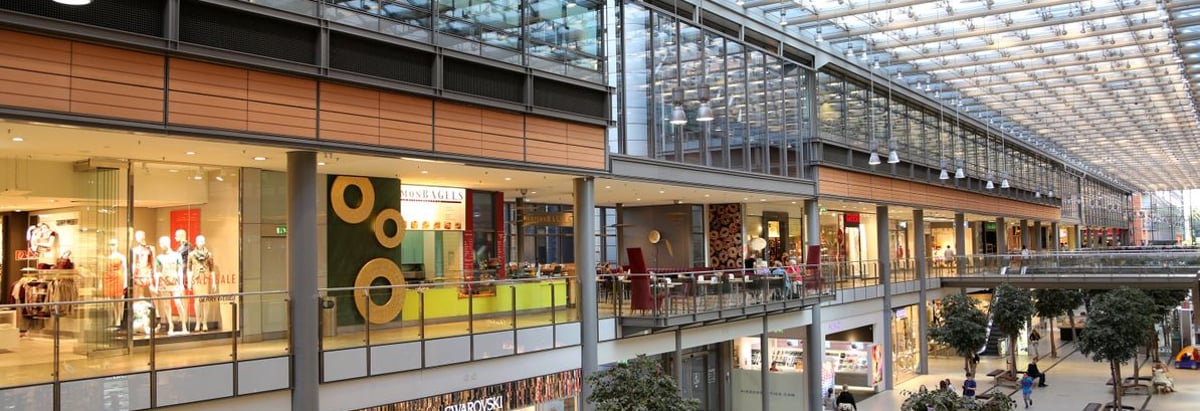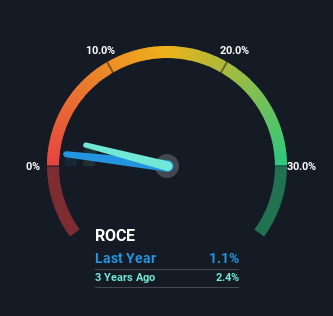- China
- /
- General Merchandise and Department Stores
- /
- SHSE:600857
Ningbo Zhongbai's (SHSE:600857) Returns On Capital Tell Us There Is Reason To Feel Uneasy

When we're researching a company, it's sometimes hard to find the warning signs, but there are some financial metrics that can help spot trouble early. When we see a declining return on capital employed (ROCE) in conjunction with a declining base of capital employed, that's often how a mature business shows signs of aging. This reveals that the company isn't compounding shareholder wealth because returns are falling and its net asset base is shrinking. Having said that, after a brief look, Ningbo Zhongbai (SHSE:600857) we aren't filled with optimism, but let's investigate further.
Return On Capital Employed (ROCE): What Is It?
For those who don't know, ROCE is a measure of a company's yearly pre-tax profit (its return), relative to the capital employed in the business. The formula for this calculation on Ningbo Zhongbai is:
Return on Capital Employed = Earnings Before Interest and Tax (EBIT) ÷ (Total Assets - Current Liabilities)
0.011 = CN¥9.3m ÷ (CN¥943m - CN¥106m) (Based on the trailing twelve months to June 2024).
Thus, Ningbo Zhongbai has an ROCE of 1.1%. Ultimately, that's a low return and it under-performs the Multiline Retail industry average of 4.2%.
Check out our latest analysis for Ningbo Zhongbai

While the past is not representative of the future, it can be helpful to know how a company has performed historically, which is why we have this chart above. If you're interested in investigating Ningbo Zhongbai's past further, check out this free graph covering Ningbo Zhongbai's past earnings, revenue and cash flow.
What Does the ROCE Trend For Ningbo Zhongbai Tell Us?
In terms of Ningbo Zhongbai's historical ROCE trend, it isn't fantastic. Unfortunately, returns have declined substantially over the last five years to the 1.1% we see today. What's equally concerning is that the amount of capital deployed in the business has shrunk by 23% over that same period. When you see both ROCE and capital employed diminishing, it can often be a sign of a mature and shrinking business that might be in structural decline. Typically businesses that exhibit these characteristics aren't the ones that tend to multiply over the long term, because statistically speaking, they've already gone through the growth phase of their life cycle.
The Bottom Line On Ningbo Zhongbai's ROCE
In summary, it's unfortunate that Ningbo Zhongbai is shrinking its capital base and also generating lower returns. Long term shareholders who've owned the stock over the last five years have experienced a 31% depreciation in their investment, so it appears the market might not like these trends either. Unless there is a shift to a more positive trajectory in these metrics, we would look elsewhere.
On a separate note, we've found 1 warning sign for Ningbo Zhongbai you'll probably want to know about.
While Ningbo Zhongbai may not currently earn the highest returns, we've compiled a list of companies that currently earn more than 25% return on equity. Check out this free list here.
Valuation is complex, but we're here to simplify it.
Discover if Ningbo Zhongbai might be undervalued or overvalued with our detailed analysis, featuring fair value estimates, potential risks, dividends, insider trades, and its financial condition.
Access Free AnalysisHave feedback on this article? Concerned about the content? Get in touch with us directly. Alternatively, email editorial-team (at) simplywallst.com.
This article by Simply Wall St is general in nature. We provide commentary based on historical data and analyst forecasts only using an unbiased methodology and our articles are not intended to be financial advice. It does not constitute a recommendation to buy or sell any stock, and does not take account of your objectives, or your financial situation. We aim to bring you long-term focused analysis driven by fundamental data. Note that our analysis may not factor in the latest price-sensitive company announcements or qualitative material. Simply Wall St has no position in any stocks mentioned.
About SHSE:600857
Flawless balance sheet and good value.


